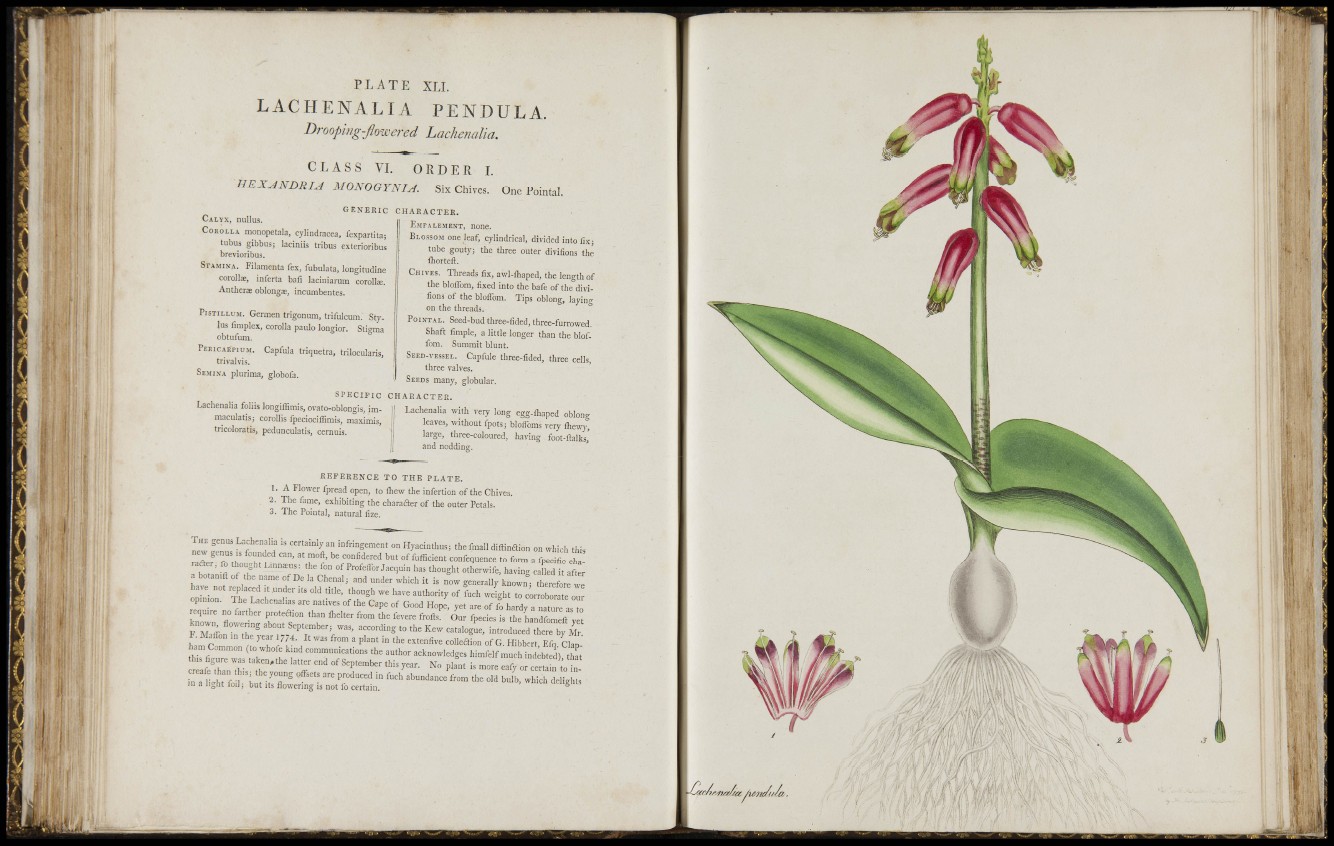
i ïîl' i •ó I
I
4
0
bO i
P L A T E XLI.
L A C H E N A L I A PENDULA
Droopmg-flowered Lachenalia.
C L A S S VL ORDER L
HEXANDRIA MONOGYNIA. Six Chives. One Pointai.
GENERIC
CALYX, nullus.
C O R O L L A monopetala, cylindracea, fexpartita;
tubus gibbus; laciniis tribus exterioribus
brevioribus.
STAMINA. Filamenta fes, fubulata, longitudine
corollíe, infetta bafi laciniaium corollte.
Antlierae oblong®, incumbentes.
P I S T I L L U M . Germen trigonum, trifulcum. Stylus
fimplex, corolla paulo longior. Stigma
obtufum. °
P E R I C A K P I U M . Capfula triquetra, trilocularis,
tri val vis.
SEMIN-A plurima, globofa.
SPECIFIC C
Lachenalia foliis longiffimis, ovato-oblongis, immaculatis;
corollis fpeciociffimis, maximis,
tricoloratis, pedunculatis, cernuis.
CHARACTER.
EMPALEMENT, none.
BLOSSOM one leaf, cylindrical, divided into iix;
tube gouty; the tliree outer divifions the
fliorteft.
CHIVES. Threads fix, awl-fliaped, the length of
the bloflbm, fixed into the bafe of the divifions
of the bloflbm. Tips oblong, laying
ou the threads.
PoiNTAL. Seed-bud three-fided, three-furrowed.
Shaft fimple, a little longer than the bloffom.
Summit blunt.
SEED-VESSEL. Capfule three-fided, three cells,
three valves.
SEEDS many, globular.
HAEACTER.
Lachenalia with very long egg-iliaped oblouoleaves,
without fpots; bloiîbms very fliewj°
large, three-coloured, having foot-ftalks,'
and nodding.
REFERENCE TO THE PLATE.
1. A Flower fpread open, to fliew the infertion of the Chives.
2. The fame, exhibiting the charaaer of the outer Petals.
3. The Pointal, natural fize.
THE genus Lnchenaha is certainly an infringement on Hyacinthus; the fmall diftinaion on which this
new genus IS founded can, at moil, be confidered but of fufficient confecjuence to form a fpJc fc ch
r a a e r , fo thought L.nnaeus: the fon of ProfeiTor J a c . u i n has thought otLrwife, having caUed i after
a botam l o f the n ame o fDe l a Chenal, and under which it is now generally known, the efore we
have not replaced it under its old title, though we have authority of L h weight to eorroboTaror
opinion. The Lachenalias are natives of the Cape of Good Hope, yet are of fo hardy a n a ^ r e as ^
require no farther proteaion than Ihelter from the fevere frofts' Jur fpecies is t h e L n ^ f t I °
F Z f o n September; was, according to the Kew catalogue, introduced there by
F. Matron in the year 774. It was from a plant in the extenfive colleQion of G. Hibbert Efo Ckn'
ham Common (to whole kind communications the author acknowledges himfelf much i d 'btd) t at
this figure was taken.the latter end ofSeptember this year. No plant is more eafy or c r n to u
i T : ; :;; . 1 ; - r r ^ ^^ r - abundance'from the old bulb, wSdi l l i ; ,
in a iigiit toil; but Its flowering IS not lo certain. ^